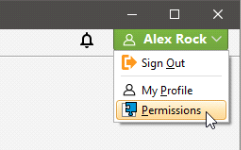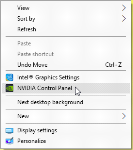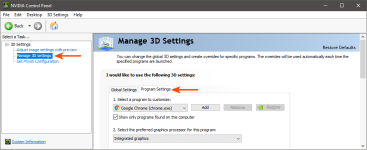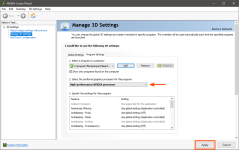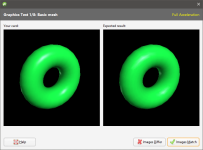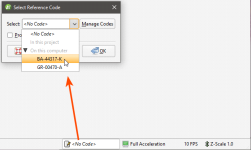Getting Started
Once Leapfrog Geo is installed, there are some first steps to carry out before you begin working with projects. This topic describes those first steps and then provides an overview of Leapfrog Geo project files. This topic is divided into:
- Signing In to Leapfrog Geo with Seequent ID
- Graphics and Drivers
- The Leapfrog Geo Projects Tab
- Recording Reference Codes
- Managing Leapfrog Geo Projects
Once you have carried out these first steps, see An Overview of Leapfrog Geo for a description of the different parts of the Leapfrog Geo main window and Concepts for information that is important to helping you get the most out of Leapfrog Geo.
Signing In to Leapfrog Geo with Seequent ID
To use Leapfrog Geo, you need a Seequent ID and the correct permissions.
If you do not have a Seequent ID, you can sign up for one by launching Leapfrog Geo and clicking the Register button.
To find out more about different permissions, visit the Flexible Leapfrog Software Subscription Options page.
Once you have a Seequent ID and the correct permissions, launch Leapfrog Geo, enter your details and click the button to sign in.
In the next window, you can:
- Select your group, if your organisation has a number of different groups.
- Select what extensions you wish to use. Some Leapfrog Geo features are only available with an extension.
- Select how long you wish to check out a seat, if your organisation is set up to check out seats on a day-by-day basis.
Select your options, then click the Get Started button.
Signing in to Leapfrog Geo also signs you in to View, so you can upload scenes to View.
The Seequent ID menu in the upper right-hand corner of the main window is used to manage your MySeequent identity.
If your organisation shares Leapfrog seats between users, signing out when you are finished working with Leapfrog Geo releases your seat for other Leapfrog users in your organisation.
The menu is displayed in grey rather than green when you are working offline. You will not be able to sign out of MySeequent when you are offline.
Graphics and Drivers
Many laptop computers come with two graphics options: low-powered graphics integrated into the CPU and a high-performance dedicated graphics option (a GPU). To save power, often the laptop’s default setting is to run programs using the slower integrated graphics option. However, selecting high-performance graphics options is very important to Leapfrog’s performance. If you have a dedicated graphics option, you should be using it. It’s also important to have the most up-to-date drivers to make the most of your computer’s capabilities.
To determine what graphics capabilities your computer has:
1. From the Leapfrog Geo menu, select About.
2. Click on the System Info tab.
Under the Summary, you will see the following details:
- Graphics in use by shows the graphics option being used. Note that Leapfrog Geo uses only the option indicated; if there are two options available, Leapfrog Geo does not use both simultaneously.
- All available graphics hardware lists the options available. If there are two options listed, you will want Leapfrog Geo to use the dedicated graphics option rather than the slower integrated graphics.
- Driver date shows the date at which the driver was last updated for each graphics option.
If your graphics drivers are out of date, it is recommended that they be updated prior to switching the graphics in use by Leapfrog Geo. To find more information:
- See the Advanced Troubleshooting Guides on the Leapfrog3D website for more information on how to update drivers for different types of dedicated graphics cards.
- Visit the My Leapfrog forums at https://forum.leapfrog3d.com/c/open-forum and search for “graphics”.
- Contact technical support as described in Getting Support.
Switching to High-Performance Graphics
If you have more than one graphics option available, ensure you are using the dedicated graphics capabilities to get the most out of Leapfrog Geo. The steps below apply to an NVIDIA driver and may be slightly different for other brands. Instructions for other brands can be found on the driver’s or laptop manufacturer’s website.
The first step is to open the NVIDIA Control Panel.
1. Right-click anywhere on your computer’s desktop and select NVIDIA Control Panel.
2. Click on Manage 3D Settings.
3. Click on the Program Settings tab.
4. Under 1. Select a program to customise, click the Add button.
5. Browse to the location of the Leapfrog Geo .exe file.
The default installation location is: C:\Program Files\Seequent\Leapfrog Geo5.1\bin\Geo.exe.
6. Once selected, click Open.
7. Under 2. Select the preferred graphics processor for this program, select the High-performance NVIDIA processor.
8. Click Apply.
On occasion, the graphics switch will be unsuccessful if the dedicated graphics card has old drivers. To ensure a successful switch, update your drivers before switching to your dedicated graphics card.
Once the drivers are updated and you have switched the in-use graphics card to your dedicated card, verify these changes have been successfully made.
9. Open the System Info window.
10. Check that the higher-powered NVIDIA card is now being used and that the drivers show the latest versions.
Running the Graphics Test
Leapfrog Geo can run in one of three acceleration modes. These modes are selected by clicking on the button at the bottom of the main window:
See 3D Acceleration Mode in Settings for more information on these settings.
A newer computer will run in Full Acceleration mode without issues. However, if you are running Leapfrog Geo on a computer that is more than five years old, it is a good idea to run the graphics test to test your computer’s graphics capabilities.
To start the test, open Leapfrog Geo and select Test Graphics from the Leapfrog Geo > Diagnostics menu:
The graphics test displays a series of image pairs that test your computer’s capabilities for the currently selected acceleration mode. For each pair, compare the images:
Even if the differences are slight, click the Images Differ button. If the images match, click the Images Match button. The next test will be displayed.
At the conclusion of the test, the result is displayed. If one or more tests have failed, information about solving problems will be displayed.
If you click on Save Report, you will be prompted to save the file on your computer.
If the test has failed, try switching to a different acceleration mode and running the test again. If possible, avoid using Software Rendering as it can be very slow.
If you cannot resolve the problem, save a copy of the graphics test report and contact technical support as described in Getting Support. Be sure to include information about your system copied from the About > System Info tab.
The Leapfrog Geo Projects Tab
After you have signed in to My Leapfrog, the Leapfrog Geo main window will appear with the Projects tab displayed:
Thumbnails for the most recent projects are displayed in the Recent projects list. The second set of thumbnails is for projects contained in the Search folder:
- Click on the folder button (
 ) or press the F5 key to change the Search folder. The Search folder is useful if you have one folder in which you keep most of your Leapfrog Geo projects.
) or press the F5 key to change the Search folder. The Search folder is useful if you have one folder in which you keep most of your Leapfrog Geo projects. - Click on the Refresh button (
 ) or press the F4 key to update the list of projects in the Search folder.
) or press the F4 key to update the list of projects in the Search folder.
Leapfrog Hydro projects are indicated in the Projects tab. See Converting Leapfrog Hydro Projects for more information.
Click on a thumbnail to open a project. You can also navigate directly to the required project file by clicking on Open Project File.
Once a project file has been opened, Leapfrog Geo switches to displaying the Scene View tab.
See Managing Leapfrog Geo Projects below for more information on saving, compacting and upgrading projects.
Recording Reference Codes
You can enter a reference code to track work on specific projects. The time associated with each reference code is included in your monthly usage report.
To enter a code, click the button in the status bar on the bottom edge of the Leapfrog Geo main window:
Select from the codes defined and click OK. The code entered will be displayed in the status bar:
To define new reference codes or delete old ones, click on the Manage Codes button. See Usage Policy Settings.
To work without a code, click on the button, select <No Code>, then click OK. Note that whether it’s possible to use Leapfrog Geo without first entering a reference code depends on a setting in the Settings > Usage Policy window.
Managing Leapfrog Geo Projects
To create a new project, click New Project at the top of the Projects tab. The new project will be saved in the Search folder.
Leapfrog Geo project files use the extension .aproj. A folder is also created that contains information used by the project.
Do not change the name of your project folder or alter its contents. Doing so could render your project file unusable.
A .lock file is created when a project is opened. The .lock file protects the project from being moved while the project is open and from being opened by another instance of Leapfrog Geo, which can happen when projects are saved on shared network drives.
If processing and display of objects in your project is too slow and your project is stored on a network drive or on a USB drive, consider moving your project onto a local drive. Leapfrog Geo is optimised for working off your local hard drive, and working from network drives and USB drives risks corrupting the project.
Saving Projects
Leapfrog Geo automatically saves an open project each time a processing task has been completed or settings have changed. Projects are also saved when they are closed so that scene settings can be restored when the project is next opened.
Saving Zipped Copies of Projects
You can save a zipped copy of a project by selecting Save A Zipped Copy from the Leapfrog Geo menu. You will be prompted to choose a name and location for the zipped project. Click Save to create the zip file.
Saving Backup Copies of Projects
You can save a backup copy of a project by selecting Save A Copy from the Leapfrog Geo menu. You will be prompted to choose a new name and location for the saved project. Click OK to create the new project file. Leapfrog Geo will save a copy of the project in the location selected.
Once the backup copy is saved, you can open and use it from the Projects tab. Otherwise, you can keep working in the original copy of the project.
Compacting Projects
When you delete objects from a project file, Leapfrog Geo retains those objects but notes that they are no longer used. Over time, the project file will grow in size and data stored in the database may become fragmented.
Compacting a project removes these unused objects and any unused space from the database. When you compact a project, Leapfrog Geo will close the project and back it up before compacting it. Depending on the size of the project, compacting it may take several minutes. Leapfrog Geo will then reopen the project.
To compact a project, select Compact This Project from the Leapfrog Geo menu. You will be asked to confirm your choice.
Upgrading Projects
When you open a project that was last saved in an earlier version of Leapfrog Geo, you may be prompted to upgrade the project. A list of affected objects will be displayed. For large projects with many objects that need to be reprocessed, the upgrade process may take some time.
It is a good idea to back up the project before opening it. Tick the Back up the project before upgrading button, then click Upgrade and Open. Navigate to the folder in which to save the backup and click Save.
For large projects with many objects, upgrading without backing up the project is not recommended.
Converting Leapfrog Hydro Projects
Leapfrog Hydro projects can be converted to Leapfrog Geo projects. However, the process is one-way, and projects opened in Leapfrog Geo can no longer be opened in Leapfrog Hydro.
When you open a Leapfrog Hydro project, you will be prompted to save a backup before converting the project.
It is strongly recommended that you back up the project before converting it.
Got a question? Visit the Seequent forums or Seequent support
